 This month’s “Cool Coop” comes from an area in the Southwest where you wouldn’t expect to find a bountiful vegetable garden, numerous fruit trees, and an abundance of flowering shrubs and flowers.
This month’s “Cool Coop” comes from an area in the Southwest where you wouldn’t expect to find a bountiful vegetable garden, numerous fruit trees, and an abundance of flowering shrubs and flowers.
When Betty Dixon and her mother, Betty Hunter, purchased their Corrales, New Mexico, property in 2003, it was a weed-infested lot with nothing more than tumbleweeds and an old abandoned car. The women, however, had a vision and determination – 12 years later the landscape is full of winding garden paths, a large variety of plantings, creative garden art and structures and – a wonderful chicken oasis!
After selling their 20-acre farm in Indiana, they considered relocating to Santa Fe, but that city apparently wasn’t rooster friendly. “I stopped in a realtor’s office and asked, ‘Where can I find property where I can have a pet rooster and maybe some hens?’” The realtor’s advice: “Corrales is the place you need to check out.”
With that guidance, Dixon explored Corrales and found what she wanted: a place to build an adobe home, have a garden and provide for the rooster. “When I saw this setting and the view of the mountain, I said, ‘Oh boy, oh boy! This is it!’”
Their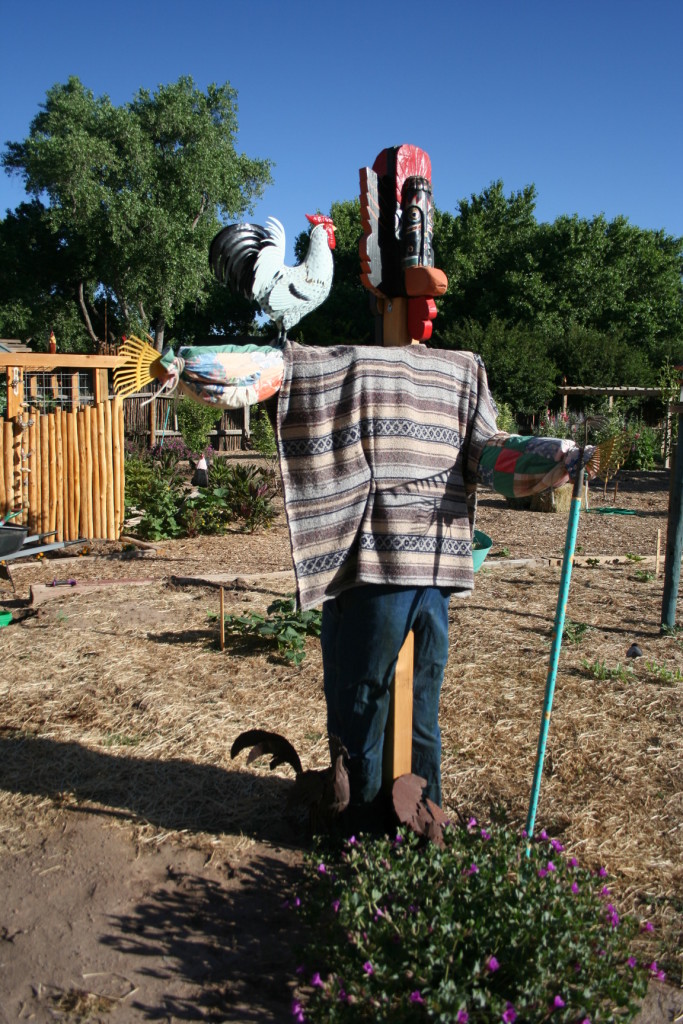 adobe home is now surrounded by sculpture-filled gardens, a wide variety of flourishing plantings and spacious, well-protected quarters for their chickens. Indeed, chickens or images of them predominate. Even the vegetable garden’s scarecrow has a chicken perched on an outstretched arm.
adobe home is now surrounded by sculpture-filled gardens, a wide variety of flourishing plantings and spacious, well-protected quarters for their chickens. Indeed, chickens or images of them predominate. Even the vegetable garden’s scarecrow has a chicken perched on an outstretched arm.
Transplanting their Midwest gardening expertise to Corrales was a challenge. “Caliche!” both women exclaimed when asked to identify the major hurdle. (Many southwestern soils have layers of caliche either on or under the surface. It’s a layer of which the soil particles have been cemented together by lime. Layers will vary in thickness from a few inches to several feet, and there may be more than one caliche layer in the soil.) Hunter looked back on the challenge, noting, “There were no nutrients in the soil —nothing. If we were going to give ourselves a challenge, this was it.” “When Mom and I told neighbors what we planned to do, some of them would drive by and snicker, thinking, ‘They don’t know what they’re up against. With the climate and the soil, they’re not going to get the gardens that they envision.’” “Yes, the caliche was horrible. Pick axes and shovels… I had people come in and plow it. We added nutrients. Tree trimmers brought in giant piles of wood chips and bark. We had llama poop, horse manure. We carted it around to all parts of the property in wheelbarrows. People passing by didn’t understand what we were doing. Why so much of it? “Well, it breaks down to nothing, so you need a lot of it,” Dixon explained. “It took three, maybe four years to work into soil. But now, it’s beautiful. I’m really happy with it, but it took a lot of Advil, a lot of sore knees and back, and sunburn. The caliche —I’d never seen anything like it.
Mulch was key to addressing another of the major differences between gardening in Indiana and in the former Rio Grande riverbed — aridity. “The water evaporating so quickly. You’d water an area, and it would be dry right away. That’s when we started using all of the mulch.” They haul in five tree trimmer truckloads of mulch every other year. They rake the older mulch into the soil before adding a new layer. The once-inhospitable, compacted dirt around the Dixon-Hunter home now hosts thousands of earthworms. Still another advantage of heavy mulching is weed control, they suggest. “We don’t have much of a weed problem at all now, but we did in the beginning,” Dixon said. “It took a couple of years to really get it knocked down, but once you get the mulch down, it’s just a matter of not letting any weeds that do come up go to seed.
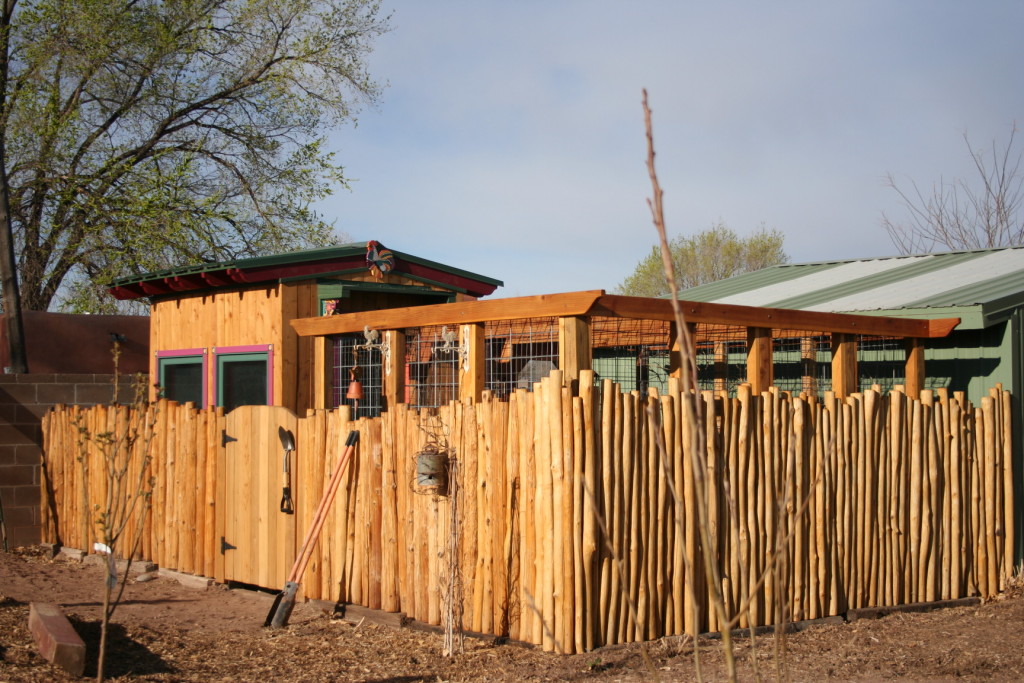
A major structural element in the backyard is the roomy, attractive chicken house produced in Dixon’s woodworking shop. “We wanted protection from coyotes, but also a coop that would be attractive. Someone had an old fence they were tearing down. They asked if we wanted the lumber. The wood was so old it was practically petrified. “We have a table saw, so we ripped the boards and then Mom sanded them. We added color to them and used them for the chicken house. It gives the chickens protection and shade. And then we put a roof on top.”
That’s a repeating pattern: wellwishers offer materials they don’t need, “and we find a use for it,” Dixon explained. “Someone gave us a lot of railroad ties, so we sunk them into the ground around the chicken house, because coyotes and racoons dig underneath a fence to attack livestock. “Mom and I dug trenches to accommodate two-deep railroad ties, and then we built the fence on top of those. Now, if anything tries to dig under to get our girls, they’re protected. And if they try to come over the top, they can’t get in that way either.”
“This is a latilla fence (Spanish word for “stick”), Betty explains. “They’re cut from spruce or pine. We were out for our usual Saturday morning garage/estate sale run – lucky we were driving “Black Betty”, our 52 Chevy. We ran across a fencing crew who was dismantling the latilla fence and putting up an adobe wall for a customer. They were glad to have someone haul the latillas away for them and we were thrilled to get them! Mom used an old draw knife that was my grandparents to clean off the old bark and what was underneath was beautiful!”
The following photos are of the construction of the coop and run…
Betty states, “I didn’t have a building plan, just windows and doors and reclaimed lumber that had to fit together somehow! I had to make sure we left enough room to be able to get to our workshop – I didn’t want to built or paint ourselves into a corner.”
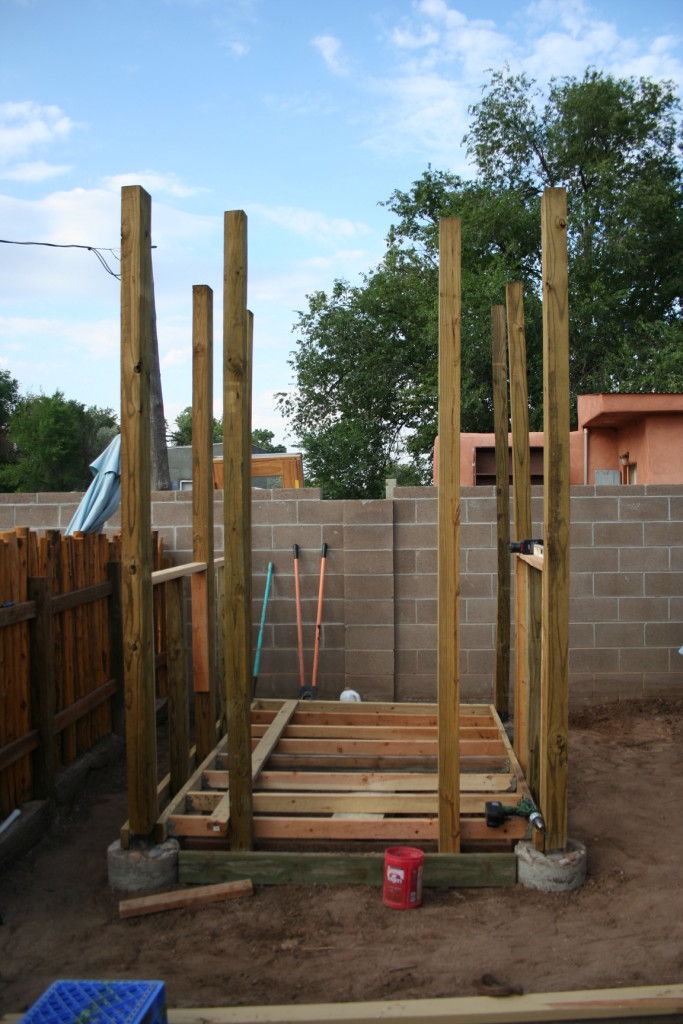

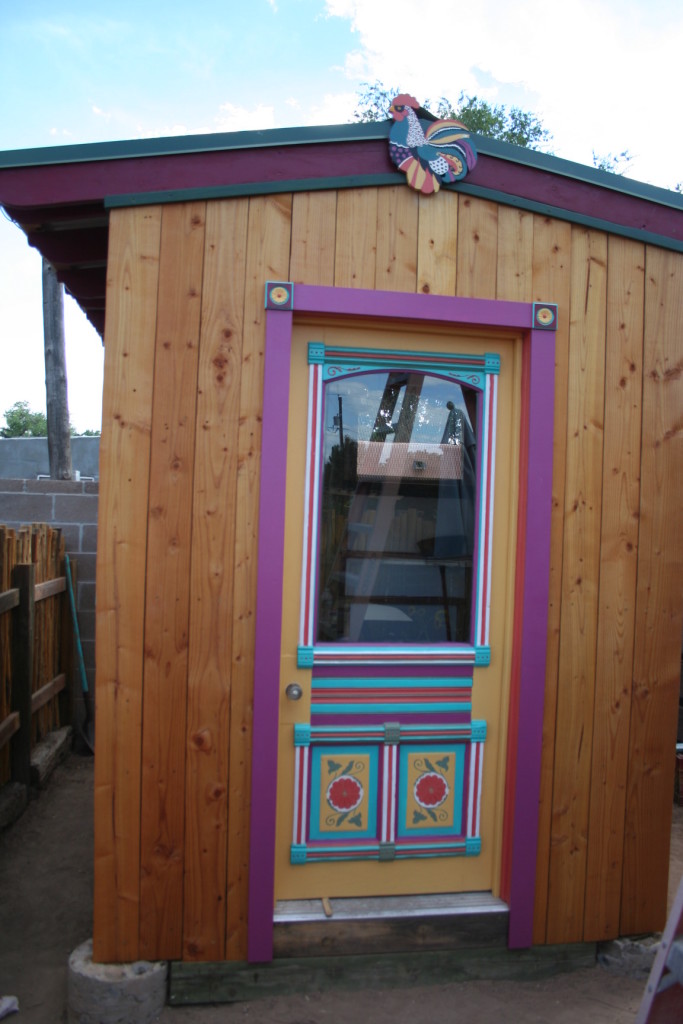

“The coop flooring is from a bonepile we picked up at a company in Albuquerque – it’s called Marmoleum (like the old linoleum) It’s made from recycled products, all bio-degradeable. I wasn’t sure if the chickens would peck at the floor, so I needed someone healthy for them and easy to clean for us.”

“I’m going to re-do the nesting boxes this fall so I can collect the eggs from the outside of the coop – that way I won’t have to disturb the girls. One of my neighbors (and fellow chicken lover) recommended putting a dishpan in the boxes- it makes it easier to take out and change their straw and sanitize.”
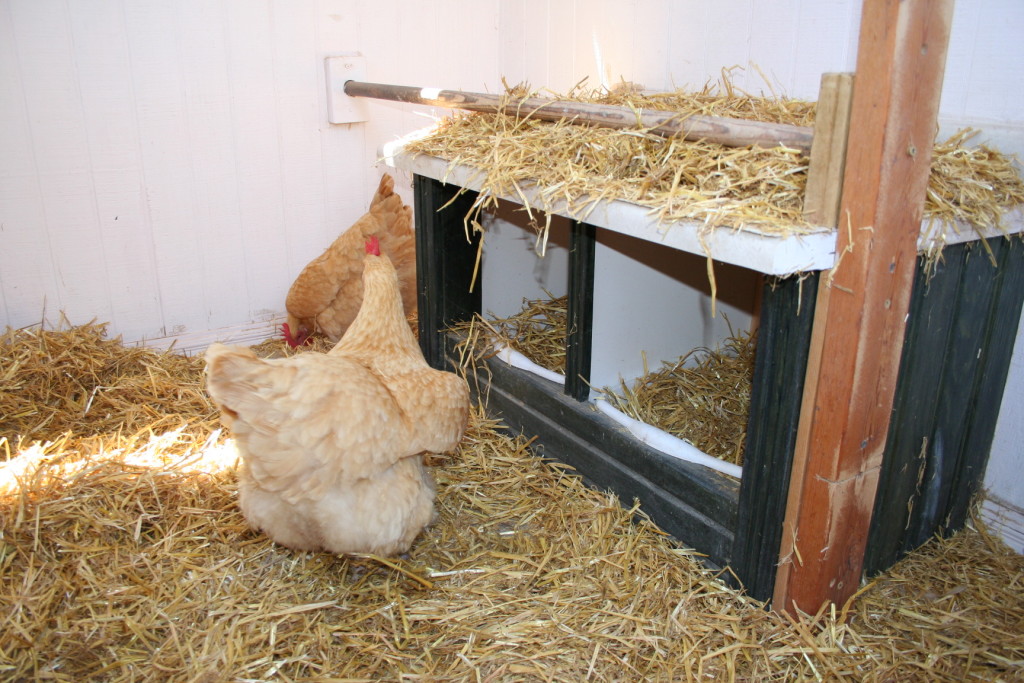

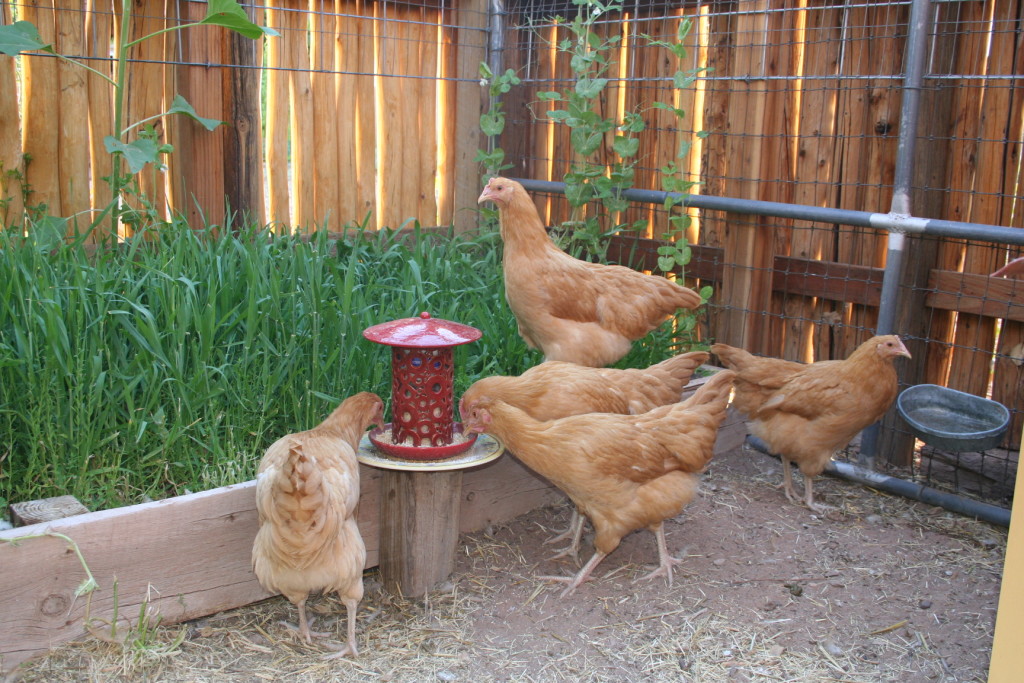 Chickens were integral to their landscaping from the beginning. “We had a lot of chickens in Indiana, but we didn’t have the problem with coyotes there. I knew we wanted eggs, and I realized that chickens are like pieces of walking art, with all the different colored feathers. “It’s like having a beautiful pet and it gives you eggs; it gives you breakfast,” Dixon explained enthusiastically. They have Buff Orpington chickens . “They’re very sweet and loving… really more like a lap dog. You can be sitting on a bale of straw and they’ll come up and next thing you know you’ve got one on your shoulder and another on your lap. “They’re not skittish, and very tame, and they lay nice brown eggs, and have a sweet demeanor.” And these elements of walking garden art help keep garden pests under control. Flying insects that enter the coop are promptly devoured. “We don’t have a problem with flies or other bugs. “The chickens love grasshoppers. We have grass around the chicken house, so the grasshoppers have a false sense of security; they’re safe, but when they hop into the chicken area —that’s it.”
Chickens were integral to their landscaping from the beginning. “We had a lot of chickens in Indiana, but we didn’t have the problem with coyotes there. I knew we wanted eggs, and I realized that chickens are like pieces of walking art, with all the different colored feathers. “It’s like having a beautiful pet and it gives you eggs; it gives you breakfast,” Dixon explained enthusiastically. They have Buff Orpington chickens . “They’re very sweet and loving… really more like a lap dog. You can be sitting on a bale of straw and they’ll come up and next thing you know you’ve got one on your shoulder and another on your lap. “They’re not skittish, and very tame, and they lay nice brown eggs, and have a sweet demeanor.” And these elements of walking garden art help keep garden pests under control. Flying insects that enter the coop are promptly devoured. “We don’t have a problem with flies or other bugs. “The chickens love grasshoppers. We have grass around the chicken house, so the grasshoppers have a false sense of security; they’re safe, but when they hop into the chicken area —that’s it.”
A big thanks goes to this inspiring mother – daughter team for sharing their beautiful gardens and chicken coop with the Community! Portions of this article were used by permission of Jeff Radford – author and publisher of the Corrales Comment. Please refer to this link for the original article: From Tumbleweeds and Caliche Soil to Lush, Chicken-Friendly Garden
If you have a “Cool Coop” you would like to share with the Community, email me at RebeccasBirdGardens@gmail.com
Click on the link below for previous entries in the “Cool Coops!” series…
To view what else is happening at our Southwest Missouri property visit: the garden-roof coop
If you enjoy bird-watching (in addition to chicken-watching), I invite you to follow my Facebook page: Rebecca’s Bird Gardens













14 Comments
So great you made it work! I live east of Santa Fe and have 50 chickens. But I don’t have any beautiful landscape, LOL.
Very Nice. This has given me needed inspiration to do something creative with our chicken habitat. I am thinking to use a lonely horse trailor as a start. It is roomy and secure and can be moved around the farm to allow our feathered friends different meal plans. Might take them to the fair like we used to do with the horses. Happy Trails from Bryn Mawr Farm here in Appalachian Mountains.
Loved the story re: ‘Cool Coops’. Would like to hear MORE about overcoming the caliche, since I’d like to move to New Mexico. And about the Adobe, since I’d like to build an in-ground house. [comments on your house?]. Do you know of [the former] Mule Creek Adobe?
Hello Pat. It’s Betty Dixon. If you’d like more information about building with adobe, how to deal with caliche or anything else, you can E-mail me at littlegreentruck@live.com and I’ll give you our phone number. I can also send you pic’s of what it looked like when mom and I started. It was quite an adventure!
What a beautiful home for your chickens! It must make you so happy to see them every day in their bright and whimsical happy-tat. Well done!
Lovely. Great results from a lot of hard work.
Cool place! I love that first photo. It’s always wonderful to hear a story of a person who has found his/her place in the world.
That door is a work of art, and the whole thing is lovely.
Thank you for inspiring with your manifest vision of beauty and care. This is wonderful to see.
Great story of perseverance and vision with Nature. Love the coop design and special touches! As a newly transplanted Californian to Washington’s rural Olympic Pensinsula, I want chickens. This inspires me! Thanks
Gorgeous! Makes my ramshackle, made from miscellaneous discards, coop look like exactly that. LOL Still, I made it myself and I am over 60 and female. Love that you used recycled materials and still made it beautiful. Girl Power! I agree about the walking (running and flying) art…I have 5 hens and it is so enjoyable to watch them in the yard. Plus they feed me! I also give an egg to each dog a couple times a week and still have enough to share with my mother, brother, grandson and his wife.
I agree about the walking (running and flying) art…I have 5 hens and it is so enjoyable to watch them in the yard. Plus they feed me! I also give an egg to each dog a couple times a week and still have enough to share with my mother, brother, grandson and his wife.
My chicken coop isn’t cool. It steel siding and doors to keep out predators.
Sounds like a great coop! A chicken doesn’t care about coolness – safety comes first – but we need to applaud the folks that go to the effort to make an affordable, attractive – and cool coop!
Your’s is “steampunk” cool!